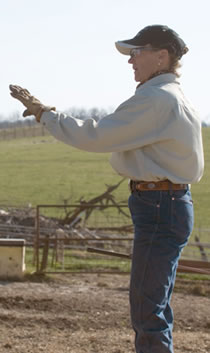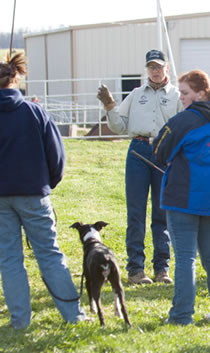Training
Handler and Cowdog Clinic ’08
I held my first Handler and Cowdog Clinic on October 25-26, 2008. I had people from 7 states. The weather was cold and windy. Cold for the people and ideal for the cattle and dogs.

I started the clinic by demonstrating how different dogs can be in their learning curve and working styles. I used five yearling dogs from the same litter. I introduced each dog to the audience and described each dog’s current working style. I told the audience things that I needed to work on with each dog in order to make the dog a more well-rounded worker. For example, Leo loves to head, but he needs to learn to also work the rear of the herd with as much aggression and enthusiasm as when I tell him to “Get ahead”. So with Leo, I demonstrated the value of teaching a dog to “Get back”.

At the end of working each yearling, I gave the audience a chance to ask questions. People were able to see “their own dog’s issues” when I demonstrated each of the five yearlings working abilities. Training young dogs gives a person a great appreciation for how different brothers and sisters can be. While they are different, it is fun and very rewarding to see them work together and independently to get the job done and done well.

After demonstrating various working and training techniques, each person was asked to tell the audience what their cattle working environment was at home. And, each person described what type of things they wanted to work on as a handler and what they wanted to accomplish with their dog at the clinic.

I started out each person’s young dog with two to three of my own dogs. I sent the dogs out to retrieve the cattle and to bring the cattle to me “Hunt ’em up and Bring ’em”. As the young dog began to work with the seasoned dogs, I had the seasoned dogs stop, one at a time, and wait while the young dog worked the cattle by itself. While I worked with each young dog, I had the handler go to the arena fence and get in a position to watch their dog work. This gave the person the chance to see how their dog was working. They saw good things and things that needed to be corrected. It's a real eye-opener to be able to watch your dog from a distance. As the young dog worked the cattle, I had the handler come off the fence to join me in the command process of handling the dog. A lot of the learning curve to make a good dog is to make yourself a good handler. Handlers have to learn to be handlers and to be a part of a team.

On day two, each person worked their dog again with me. They then worked their dog by themselves. Then, I had all the young dogs work together as a team. By the end of the clinic, I had all the young dogs working together with their handlers.

A big part of the success of the clinic was the participation of all the people in asking questions. There were a lot of really good questions and each question helped others see and know that there are other people with similar things that they want to correct in order to be a better handler. Improving your handling skills helps you create a better partnership between yourself and your cowdog.
I enjoyed working with each person and each dog at the clinic!
—Tammy


